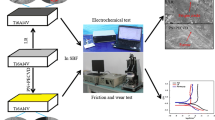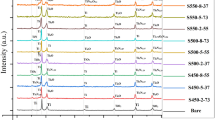Abstract
DC glow discharge plasma nitriding is the process of surface hardening through the spread of nitrogen atoms to the metal surface under special conditions of the plasma nitriding. Titanium and titanium alloys are the most common alloys used in medical applications. Titanium and its alloys are lightweight, corrosion resistant, and have good fatigue properties but lack wear resistance under aggressive environments. The plasma nitriding process was used for a titanium alloy (Ti–6Al–4V) rod with different parameters at a vacuum chamber of air (2 mbar), 680 volts and 30 mA. The plasma nitriding process was performed at different nitriding times (5, 10, and 15 h), and the effect of plasma nitriding was examined on the chemical compassion of Ti–6Al–4V alloy and the appearance of phases was studied by optical microscopy (OM), scanning electron microscopy and field emission scanning electron microscopy (FESEM), X-ray diffraction (XRD), Tafel potential polarization, and cyclic polarization. The results indicate that the formation of layers and phases Ti2N and Ti2N3−x on a surface of the alloy were achieved, which would improve the surface characteristics of chemical corrosion in simulated body fluid.






Similar content being viewed by others
References
Hacisalihoglu I, Samancioglu A, Yildiz F, Purcek G, Alsaran A (2015) Tribocorrosion properties of different type titanium alloys in simulated body fluid. Wear 333:679–686
Pejakovi V, Totolin V, Ripoll MR (2018) Tribocorrosion behaviour of Ti6Al4V in artificial seawater at low contact pressures. Tribol Int 119:55–65
Aghajani H, Behrangi S (2016) Plasma nitriding of steels, 1st edn. Springer, Cham
Li J, Zhang Y, Zhao Y (2017) Mechanical properties of TiN ceramic coating on a heat treated Ti-13Zr-13Nb alloy. J Alloy Compd 724:34–44
Raaif M, El-Hossary FM, Negm NZ, Khalil SM, Schaaf P (2007) Surface treatment of Ti–6Al–4V alloy by rf plasma nitriding. J Phys 19:1–12
ASTM (2005) Designation: E 407-99 standard practice for microetching metals and alloys. ASTM, West Conshohocken, PA
Oliveira VMCA, Aguiar C, Vazquez AM, Robin A, Barboza MJR (2014) Improving corrosion resistance of Ti–6Al–4V alloy through plasma-assisted PVD deposited nitride coatings. Corros Sci 88:317–327
Itagaki H, Hirose S, Kim J, Ogura M, Wang X, Nonaka A, Ogiso H, Sakakita H (2016) A low-power nitriding technique utilizing a microwave-excited radical flow. Jpn J Appl Phys 55:1–5
Jin J, Duan H, Li X (2017) The influence of plasma nitriding on microstructure and properties of CrN and CrNiN coatings on Ti6Al4V by magnetron sputtering. Vacuum 136:112–120
Yildiz F, Yetim AF, Alsaran A, Çelik A (2008) Plasma nitriding behavior of Ti6Al4V orthopedic alloy. Surf Coat Technol 202:2471–2476
Joska L, Fojt J, Hradilova M, Hnilica F, Cvrcek L (2010) Corrosion behaviour of TiN and ZrN in the environment containing fluoride ions. Biomed Mater 5(5):054108
Yetim AF, Alsaran A, Efeoglu I, Çelik A (2008) A comparative study: the effect of surface treatments on the tribological properties of Ti–6Al–4 V alloy. Surf Coat Technol 202:2428–2432
Czarnowska E, Wierzchon T, Maranda-Niedbala A, Kerczmarewicz E (2000) Improvement of titanium alloy for biomedical applications by nitriding and carbonitriding processes under glow discharge conditions. J Mater Sci Mater Med 11(2):73–81
Jirarungsatian C, Prateepasen A (2010) Pitting and uniform corrosion source recognition using acoustic emission parameters. Corros Sci 52:187–197
Razavi RS, Gordani GR (2011) A review of the corrosion of laser nitrided Ti–6Al–4V. Anti- Corros Methods Mater 58:140–154
Acknowledgements
The authors would like to thank the Ministry of Science and Technology—Materials Research Center, University of Technology—Production and Metallurgy Engineering Department—Iraq, and Kurdistan University—Electron Microscopy Lab—Iran for their assistance.
Author information
Authors and Affiliations
Corresponding author
Additional information
Publisher's Note
Springer Nature remains neutral with regard to jurisdictional claims in published maps and institutional affiliations.
Rights and permissions
About this article
Cite this article
Hammood, A.S., Thair, L. & Ali, S.H. Corrosion Behavior Evaluation in Simulated Body Fluid of a Modified Ti–6Al–4V Alloy by DC Glow Plasma Nitriding. J Bio Tribo Corros 5, 100 (2019). https://doi.org/10.1007/s40735-019-0290-0
Received:
Revised:
Accepted:
Published:
DOI: https://doi.org/10.1007/s40735-019-0290-0




